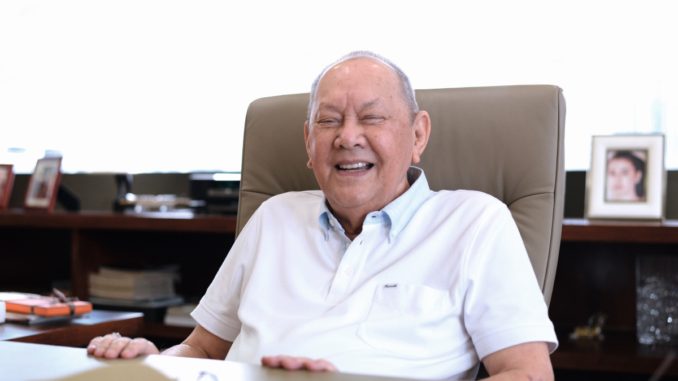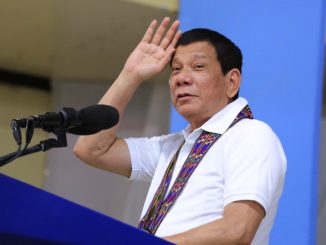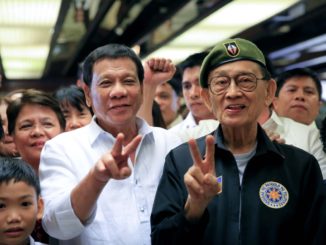
At 82, Eduardo M. Cojuangco Jr. seems to have run out of ambition. Not that he has failed. Nor achieved less than what he aimed for, from early in his business life. “I have achieved more than what I have intended to do in life,” he said a few days before turning 82 on June 10. “I never imagined I could reach this far,” he muses. “Everything that has happened I never even dreamed of.”
After eight decades of a marvelously extraordinary life, one lived mostly for the betterment of others and his country, Cojuangco is a portrait of contentment. “I have enough in life,” says the Philippines’ most successful industrialist, the chairman and CEO of San Miguel Corp. (SMC) and a number of other large enterprises. “With it, I can do what I want to do.”
Forbes magazine lists Cojuangco as one of the Philippines’ 12 richest Filipinos, with wealth of $1.2 billion, a grossly understated amount in my reckoning.
Cojuangco is often known as Danding, ECJ or “Boss” to friends, allies, subalterns, and business associates. With his tremendous success and achievements as a businessman and as a public servant he is revered, respected, loved, and sometimes, feared and loathed, by business and political rivals, and critics.
ECJ’s entrepreneurship and public service have served a singular purpose – to uplift the lives of many Filipinos and contribute to a stronger national development.
His success neatly straddles many facets of Philippine society – business, agriculture, public service (he was Tarlac governor and ambassador), sports (his La Salle team is UAAP champion and San Miguel owns three champion basketball teams), education (he funded 5,000 high school teachers to get masters or doctorate degrees to improve the quality of secondary education), and philanthropy (he gave away thousands of hectares of land to poor farmers).
Cojuangco manages a number of large enterprises, many of them No. 1 in their industry. An agriculturist by training and habit, he has attempted to modernize Philippine agriculture, notably coconut and sugar.
How he invested coco levies
In 1983, he borrowed P2.57 billion or 26% of the then P9.69 billion in coco levies collected from 1972 to August 1982 when they were stopped. Note that our so-called coconut farmers did not own a centavo of the P9.69 billion. The P9.69 billion was collected from coconut millers and exporters, not the coconut farmers. Cojuangco was a large contributor to the levy.
Cojuangco used a modest P115.52 million of the P2.57 billion of coco levy money to acquire control of First United Bank, from his uncle. FUB became what is today UCPB which quickly became the first universal bank, the No. 1 domestic bank in equity, and the No. 2 domestic bank in resources. After the 1986 People Power, Cojuangco was ousted from bank management. Politics and three decades of litigation hampered UCPB’s once frenetic growth. Still, today, UCPB has assets of P294.22 billion, deposits of P252 billion, and equity of P17.59 billion. Thus, an investment of P115 million became an asset worth P294.224 billion by 2016, not a bad deal. It’s like earning P294.1 billion or 255,746% in 33 years (1983 to 2016) or 7,750% per year!
P1.65 billion invested in SMC in 1983
Also spectacular is what Cojuangco did with the P1.65 billion out of the P9.69 billion. He used the P1.65 billion to acquire 31% or 33.13 million common shares of SMC in 1983. The shares were later converted into preferred shares. In May 2015, the shares were redeemed by SMC management which paid in cash, P56.53 billion.
Additionally, before their redemption, the so-called government shares earned P12.727 billion from 1984 to 2009 as common shares, plus P13.569 billion in cash dividends from preferred shares (the common shares were converted into preferred). So P56.53 billion plus dividends of P12.72 billion (from common shares) and P13.56 billion (from preferred shares) ballooned to P82.83 billion in worth by the end of 2012.
Stupendous yields from SMC and UCPB
That P82.83 billion, had it been properly managed, should have continued growing in succeeding years. At 5% interest or yield per year, P82.83 billion would be worth P86.76 billion in 2013 (P82.83Bx1.05%); P86.766 billion in 2014 (P82.83×1.05%); P91.104 billion in 2015, P91.104 billion in 2016; and P102.954 billion by the end of June 2017 (January-June 2017).
Recall that the P102.95 billion value of coco levy investment in San Miguel was only P1.65 billion in 1983. That represents an increase in value of a whopping P101.3 billion or 6,339%. Divided by 33.5 years (from 1983 to June 2017), that’s equivalent to a yield of 183.25% per year.
So Cojuangco, in effect, was making 7,750% per year for 33 years from the money he invested in UCPB, and 183.25% per year from the money invested in San Miguel for 33.5 years.
P397 billion gift to coconut farmers
Combine the P102.95 billion present value of SMC investment of P1.65 billion and the P294.22 billion assets of UCPB today and you have P397.2 billion of assets. The government keeps insisting those assets belong to the country’s some four million coconut farmers.
Unfortunately, the earnings from San Miguel are not worth P102 billion today, if you ask government people. Figures vary because the earnings in cash dividends from the common and later preferred shares went into the national government’s General Fund.
P56B redemption
That leaves the P56.53 billion in redemption value personally handed over by Cojuangco to the government in 2015. It should have swelled to P68.72 billion by the end of 2016, assuming a 5% annual yield, and to P72.159 billion by end-June 2017.
As for UCPB, the government is in the process of privatizing the bank. But it is doubtful whether the state can sell the bank without ECJ’s active consent or participation. He owns at least 7.72% of UCPB, probably more if a closer scrutiny of the bank’s ownership structure was made.
Transforming San Miguel
In tandem with his trusted friend, adviser and executive, Ramon S. Ang, Cojuangco transformed San Miguel and nurtured it to become the Philippines’ largest and most diversified conglomerate.
Cojuangco, as chairman and CEO, presides over the largest, most profitable and most diversified conglomerate in the Philippines, San Miguel Corp. where he has been the chairman and chief executive officer (CEO) since 1998.
Today, SMC has P1.3 trillion in resources, P700 billion in annual sales, P52 billion in profits (in 2016), P250 billion in market capitalization, and unrivalled leadership in seven key businesses – beer and beverages, processed food, packaging, fuel and oils, power generation, tollways (58% of the market in kms and 80% of revenues), and other infrastructure.
SMC’s sales in 2016 accounted for 4.7% of the Gross Domestic Product or the total output of goods and services. No other company comes close.
Cojuangco sees San Miguel as only one facet of his business success. More importantly, he believes, he likes to point at the incredible earnings he has made for the Philippine coconut industry as the better yardstick of what he has done in San Miguel and for the Filipino people.
Ailments
Cojuangco has, of course, battled major ailments –kidney (he had a transplant in late 2013), heart, liver, lungs, occasional pneumonia—and miraculously, conquered all of them. He looks as hale and hearty as a man half his age yet, with double the achievements of tycoons and peers of his generation.
San Miguel is Cojuangco’s teenage dream. Back in the late 1950s, when he was 16 or 17, he would pass by Ayala Avenue and gazed at the skyscraper that was the San Miguel headquarters then.
He wondered what it would take to take over a company as large as San Miguel and manage it. In just three decades, Cojuangco fulfilled his dream as teener. In 1983, he did something nobody thought before was possible. He bought and took over majority control of the beer and beverage behemoth. Despite being the majority owner, he entered into a voting trust agreement with the group of Andres Soriano Jr. allowing the Sorianos full management and control of San Miguel. Then in 1986, People Power ousted the regime of Ferdinand E. Marcos, forcing the family’s exile, along with Cojuangco and his family.
Cojuangco returned to the Philippines in 1989 determined to help his country recover from a debilitating recession and political turmoil. He sought the presidency in 1992. He lost in a close fight. Fidel Ramos won with 23.6% of the vote. Miriam Defensor Santiago, second with 19.7% and Cojuangco third with 18.2%.
ECJ’s vice presidential running mate, Joseph Ejercito Estrada, won in 1992. In 1998, Estrada ran for president and won by an overwhelming mandate.
Despite having control of SMC, Cojuangco was not allowed to take direct control of the brewery and food giant during Ramos’s time.
Only in July 1998 did Cojuangco maneuver to get back his crown jewel. He brought with him as his special assistant a man who would be crucial to San Miguel’s future success, Ramon S. Ang. Ang was named vice chairman on Jan. 28, 1999 and president and chief operating officer since March 6, 2002. “Ramon was a diamond in the raw,” Cojuangco said of his subaltern then and who became San Miguel’s most valuable asset. “In talent and people skills, nobody can match Ramon. It is a gift one is born with,” says Cojuangco of San Miguel’s best president ever.
SMC’s social purpose
In 2012, addressing its annual meeting, Cojuangco defined San Miguel’s importance to its stockholders and to the nation.
The chairman said: “We believe that San Miguel’s long-term value rests on fulfilling a social purpose. The unique portfolio of businesses we manage today will set us up for the future and perhaps even leave the country and our countrymen a little better off in the process.”
“As our nation’s leading corporation, we aspire to do our share in terms of job creation, rural development, improving infrastructure and encouraging the growth of tourism. Our financial strength provides us the means to have a positive and meaningful impact on these issues,” Cojuangco added.
Why Infra
Why has San Miguel gone heavily and aggressively into infrastructure, an area in which the Philippines has lagged badly behind its ASEAN neighbors? The business is not exactly hugely profitable. “It will take us as long as 20 years to get back our investments,” reckons SMC President Ramon Ang. That means a return of as low as 5% a year, so why would SMC be heavily exposed in infrastructure? “It is because our business is development,” Ang replies wryly. “We want to contribute to our country’s growth.”
Social purpose is a principle Cojuangco imbibed early in his business life. At age 17, he took over the family’s money-losing plywood business after his father, Eduardo Sr., himself a former governor of their native Tarlac province, died. In a brief time, the young college dropout turned around the company by learning hands-on all the aspects of plywood manufacturing, employing innovations and savvy management. After the turnaround, however, Danding urged his mother, a half-American, to sell the business. Why? Because plywood making involved the cutting of trees and he felt the family would be blamed for future floods.
SMC CSR
San Miguel itself has spent easily P1.5 billion in corporate social responsibility projects from 2012 to 2016. Projects include education, health and nutrition, environment, mass housing for the homeless and typhoon victims, and large drug rehabilitation centers. Tree planting is a major undertaking – one million seedlings of coconut, coffee and cacao in Sual, Pangasinan. Planting of more than 500,000 trees nationwide in partnership with the armed forces. Tree and mangrove planting and rehab of creeks and rivers by SMC’s subsidiary Petron.
Ramon Ang takes pride in SMC producing the cleanest energy from coal and in Petron having the most modern refinery with zero waste product (every byproduct is converted into energy).
This 2017, Ramon projects profits of P65 billion on revenues nearing or exceeding P800 billion. That should make San Miguel No. 1 in both profits and revenues. “What is important is not the revenues,” cautions Ang, “it is the profits.” Despite its size and scale and despite starting from a high base, San Miguel, Ang promises, “will remain a very profitable company.”
For his part, Cojuangco sees San Miguel as only one facet of his business success. More importantly, he likes to point at the incredible earnings he has made for the Philippine coconut industry as the better yardstick of what he has done in San Miguel and for the Filipino people.



